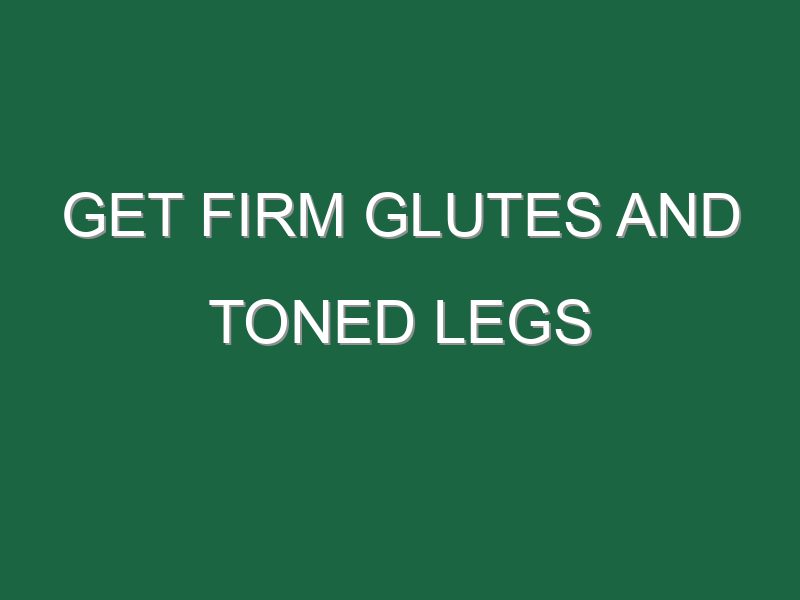Unless you’re lucky enough to live in the sun-basked South or on the West Coast, you were forced to cover up like an Egyptian mummy during the cold winter experienced by much of the country. The problem with covering up is that it enables you to forget about the fact that too much indulging occurred over the winter and the long evenings that followed. After all, if it’s out of sight, it’s easy to forget that your lower body is not as tight as it once was – or at least as tight as you want it. What can be done if your lower body needs some fine-tuning? Besides a healthy diet and increasing your cardio, try lunges for firm glutes and strong, toned thighs.
This may be time to reassess your workout strategy to optimize your results, depending on your goals. Have you boosted your cardio to four or five times a week (six is even better)? Cardio will not interfere with your resistance training objectives if you have planned your routines properly. Have you started to pay attention to what you’re eating and when you’re eating it? There are no quick fixes, but an honest, unwrapped assessment in the mirror will quickly tell you if you should pay special attention to your gluteals, or perhaps your thighs. If that’s the case, lunges may be perfect for you. The step lunge is a compound exercise, which means it is simultaneously effective for many muscles rather than focusing on one isolated muscle or region of a muscle. The lunge strongly activates and tightens the gluteal muscles, the hamstring muscles of the posterior thigh, and the quadriceps muscles of the anterior thigh. These muscles make up most of the bulk of your lower body.
Closer Look at the Gluteal Muscles
There are three sets of gluteal muscles, but the gluteus maximus is the largest and thickest muscle of all the hip muscles. It contains the strongest and largest muscle fibers in the body (even surpassing the muscles of the thigh and back). The upper attachment of the gluteus maximus is on the bones of the hip, while the lower attachment is on the posterior side of the femur bone of the thigh below the hip joint. This strong muscle pulls the thigh posteriorly (backward) in an action described as thigh extension.
There are three hamstring muscles that live on the posterior side of the thigh. The biceps femoris has a long and a short head. The long head begins on posterior part of the ischial bone of the hip (you sit on this bone), whereas the short head begins along the lateral side of femur bone of the thigh. Both heads of the biceps femoris combine to become a single tendon that attaches to the small lateral bone of the lower leg called the fibula. The semitendinosus and semimembranosus muscles make up the medial (inside) hamstring muscles. The semitendinosus muscle attaches to the ischial bone of the hip and it becomes a cord-like tendon as it approaches the knee. The semimembranosus muscle is about half (“semi”) membrane (“membranous”) and half muscle. It begins on the ischial tuberosity and with the semitendinosus, it crosses to the medial side of the knee to attach on the tibia bone of the lower leg.
The quadriceps femoris (“quads”) is a family of four muscles living on the anterior (front) portion of the thigh. The rectus femoris muscle fibers run straight down from the hip, along the front of the thigh to join the quadriceps tendon above the kneecap (patella). The rectus femoris extends the leg at the knee joint. However, unlike the vastus muscles, the rectus femoris begins at the hip, so when the hip is flexed, the rectus femoris is slackened and therefore, functionally weaker than when it is straight. The vastus lateralis muscle lies on the lateral (outer) part of the thigh; the vastus medialis covers the medial (inner) part of the thigh; and the vastus intermedius is located intermediately between the vastus lateralis and the vastus medialis. The fibers from the three vastus muscles blend together to form the quadriceps tendon that attaches to the patella. It continues from the patella as the patellar ligament and attaches to the tibia just below the knee joint. All four quadriceps muscles help extend the leg (straighten the knee joint).
Step Lunges
It is not necessary to use more than bodyweight to start with, because the most critical element is to establish perfect exercise form. After that, you can slowly add resistance by holding a light dumbbell in each hand.
1. Stand in front of a step (approximately six to eight inches high) or a box. You could also move to a flight of stairs and work on the bottom step. Begin with your feet together and about three feet in front of the step. If you have long legs, you will have to back up so you are forced to take an exaggerated step forward with the front leg.
2. One leg will act as an anchor (e.g., the left leg). The other leg (e.g., the right leg) will lunge forward with the goal of placing in on top of the step that is in front of you. The knee of the forward leg will bend as you lunge forward, while the knee on the anchor leg will remain straight.
3. It is very important that you take a long stride with the forward leg. If you are too close to the step, your lunge will be short and this will result in forming a sharp knee angle when you’re in the lunged position. It is unnecessary and undesirable to have this acute knee angle because this increases knee stress without any advantage given to your thighs or gluteal muscles.
4. As you lunge forward, lower the knee on the anchor (left) leg toward the floor. Keep your trunk in an upright position and do not lean forward from your waist during the lunge. Lower your body toward the floor, but stop when the angle of the front knee is 90 degrees. Your knee joint should be over the ball of your foot, not a large distance in front of your foot. You should experience a stretch across the hamstrings of the anchor leg and the thigh of the forward leg. Lowering your body at the completion of each step lunge should not be a ballistic or a fast movement, otherwise you will leave yourself open to muscle damage, or you might lose your balance and fall.
5. Push your body back up to its standing position with the forward leg so that both feet end adjacent to each other. This can be done quite forcefully, as long as your knee angle on the forward leg is not less than 90 degrees when you start the return phase. Avoid pushing up with the straight anchor leg. After assuming the standing position from which you started, you can repeat this with the other leg. Alternatively, you can complete all of your lunges with one leg before moving to the other leg.
Lunge Tips and Alternatives
The gluteal, hamstring and quadriceps muscles are all very active during the initial thrust back to the standing position (leg extension and hip extension). The deeper the lunge and the greater the stride, the greater the stretch and activation of all of the affected muscles. However, you must work into this slowly. After you have mastered the smaller step, try a larger step or block (e.g., 12 inches) or step up two steps on a stairway. After a few weeks, you can increase resistance by holding a light dumbbell in each hand (e.g., start with about 2.5 pounds in each hand). After you have accommodated to this, and as long as your exercise form is still perfect, you can progress to heavier weights, but the goal is not to use huge weights in this exercise.
You should also stretch your hamstrings, calves and quadriceps prior to beginning the exercise. Be careful that you do not bend too far forward during the lunge. If so, you are likely using too much weight and/or your stride is too short. The second common mistake is that the front knee angle is too acute at the lowest part of the lunge, and this is correctable by taking a longer stride into each lunge.
The benefits of step lunges to your overall program will be huge and they will provide a greater spring in your step and shape in your hips and entire lower body. Even folks suffering from joint pain, including arthritis, can benefit from carefully applied compound lower-body exercises such as lunges. There is still plenty of time to lunge your way into shapelier hips and thighs, but there is no time better to start than now!
References:
Babuccu, O., Gozil, R., Ozmen, S., Bahcelioglu, M., Latifoglu, O. and Celebi, M. C. (2002). Gluteal region morphology: the effect of the weight gain and aging. Aesthetic Plast Surg 26, 130-133.
Bearne, L. M., Scott, D. L. and Hurley, M. V. (2002). Exercise can reverse quadriceps sensorimotor dysfunction that is associated with rheumatoid arthritis without exacerbating disease activity. Rheumatology (Oxford) 41, 157-166.
Booth, F. W., Chakravarthy, M. V., Gordon, S. E. and Spangenburg, E. E. (2002). Waging war on physical inactivity: using modern molecular ammunition against an ancient enemy. J Appl Physiol 93, 3-30.
Hefzy, M. S., al Khazim, M. and Harrison, L. (1997). Co-activation of the hamstrings and quadriceps during the lunge exercise. Biomed Sci Instrum 33, 360-365.
McCarthy, J. P., Pozniak, M. A. and Agre, J. C. (2002). Neuromuscular adaptations to concurrent strength and endurance training. Med Sci Sports Exerc 34, 511-519.
Pincivero, D. M., Aldworth, C., Dickerson, T., Petry, C. and Shultz, T. (2000). Quadriceps-hamstring EMG activity during functional, closed kinetic chain exercise to fatigue. Eur J Appl Physiol 81, 504-509.
Stuart, M. J., Meglan, D. A., Lutz, G. E., Growney, E. S. and An, K. N. (1996). Comparison of intersegmental tibiofemoral joint forces and muscle activity during various closed kinetic chain exercises. Am J Sports Med 24, 792-799.
Vincent, H. K. and Vincent, K. R. (1997). The effect of training status on the serum creatine kinase response, soreness and muscle function following resistance exercise. Int J Sports Med 18, 431-437.
The post Get Firm Glutes and Toned Legs first appeared on FitnessRX for Women.





